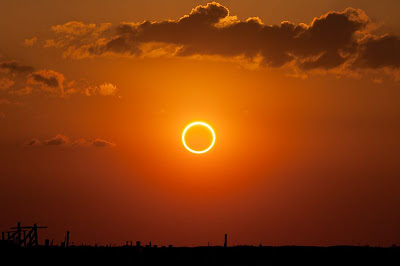.....What is a little more notable is that both of these are happening on the same day. Since the Moon is at its closest point, the Moon will appear a little larger in the sky than it usually does, and therefore a little brighter. How much of a difference will this make?
 |
| This ain't it. |
....Not all that much. The orbit of the Moon has an eccentricity of 0.0549. The eccentricity describes the shape of a curve. A circle has an eccentricity of 0, a parabola has an eccentricity of 1.0, and a ellipse has an eccentricity between these two values. The Moon's orbit isn't too far from a cicle.
.....On this diagram, the Moon's orbit is sketched in red, while a perfect circle is sketched in blue. While the difference is not gigantic, it is there, and it does affect the "Supermoon". (Should I capitalize that? Will Time/Warner/DC sue me? I am not sure.)
.....This means that the Moon at its closest appears 11.8% larger than the Moon at its smallest. Since the brightness depends on the cross-sectional area, the Moon at its closest appears to have a 25% larger area against the sky, compared to the Moon at its farthest, or 11% more than the Moon at its average distance from the Earth. This doesn't have as big an effect as you might think, because 25% more light doesn't mean that it would appear 25% brighter. Consider that when you wake up in the middle of the night and navigate your way through your place, you can see to do that. When you walk outside at noon the next day, you can see then as well, without your eyes exploding. In astronomical terms, this is less than one magnitude difference (in which 5 magnitudes separates a bright star from the faintest visible stars)
...Even in terms of size, the Supermoon will not stand out greatly. In the image below (constructed by the author from an image by NASA), the Supermoon is compared by the minimum Moon).
.....But we don't see the Moon compared with itself, we see the Moon against the background stars, and that does not stand out.
.....In fact, the Moon will be at its least impressive (in the Northern Hemisphere) because this is so close to the Summer Solstice, it happens when the Sun is at the northernmost point in its path across the sky , which means that the Moon will be at the southernmost point in the ecliptic (the path that the Sun, and basically the Moon and planets as well) follow across the sky. To take a sample latitude of, say, 44 degrees north latitude, the Sun will be almost 70 degrees above the horizon at its highest, and the Moon that night will only be at 26 degrees above the horizon. The Sun will spend 13 hours above the horizon, while the Moon will only be up for nine hours.
.....This might be a good thing, for casual hanging-out-and-looking-at-the-Moon purposes. The not well explained horizon illusion causes the Sun or Moon to appear larger (even when it isn't) if it is rising or setting. If the Moon is close to the horizon all night, there is more of a chance for this. If the Moon is low in sky, it is also easier to hang out and look at the Moon from a chair on your porch, hanging out with your friends. (NOTE: obtain friends before trying this.)
..... There is one major effect caused by the Moon's elliptical orbit. For absolutely no good reason (you could claim this as evidence for a God if you didn't mind a kinda weird and petty god), the angular size of the Moon in the sky is basically the same as the angular size of the Sun in the sky. This means that when the Moon moves in front of the Sun, the entire Sun can be covered, resulting in a solar eclipse. When the Moon is at its far point, the Moon does quite do it, and we are left with an annular eclipse.




No comments:
Post a Comment